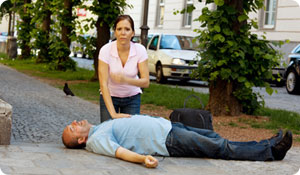
Studies show that most people would not perform mouth-breathing CPR if they saw someone collapse. The good news for would-be heroes is that the American Heart Association now recommends a life-saving version of CPR requiring only your hands. So all you need to do to help someone suffering from cardiac arrest is to perform chest compressions.
What Is Hands-Only CPR?
Cardiopulmonary Resuscitation (CPR) is a procedure that allows you (the resuscitator) to manually keep blood flowing through the body of a person whose heart has suddenly stopped functioning normally. CPR can keep a person's organs healthy for several minutes while you wait for medical help. This can significantly limit permanent damage and increase a person's chances of survival. Unfortunately, 59 percent of those who go into cardiac arrest outside of a medical facility don't receive this life-saving attention even when witnesses who have been trained in CPR are on hand to help. Studies show, though, that those who know about the hands-only technique are more likely to step up.
The American Heart Association boils the process down to two steps:
Step 1: Call 911 to ensure that medical attendants are on their way.
Step 2: Start chest compressions to keep the blood flowing until emergency responders arrive.
To correctly perform chest compressions, follow these tips:
- Find the center of the chest. This is the notch along the breastbone located between the nipples.
- Place the heel of one hand down on this spot and put the other hand on top of it. You might want to interlock your fingers to ensure that you don't put pressure on the chest walls.
- Push down hard and fast. Aim for at least 100 beats per minute. If you're not sure how fast that is, try pushing in rhythm to that old Bee Gees classic "Staying Alive."
- Push deep. Your goal should be to push the chest in at least two inches deep.
- Try to get someone to help you keep it up. After just a few minutes, you may feel tired and have a hard time keeping up the rhythm. If possible, take turns with another bystander, but as you switch try to maintain 100 plus beat per minute to avoid any interruption in blood flow.
All this pushing may raise another fear: breaking a person's bones. It does happen. In fact, it's estimated that in more than 30 percent of instances, resuscitators fracture a victim's ribs or breastbone. But these breaks should not cause any serious injury. The other option, of course is doing nothing, which is very likely to increase a person's risk of dying or being severely disabled following cardiac arrest.
When to Use Hands-Only CPR
The hands-only method of CPR is recommended for use on teens and adults who you see suddenly collapse. For Infants and children under 13 or anyone who is a victim of drowning or a drug overdose, the American Heart Association recommends traditional CPR with mouth-to-mouth breathing. It's also recommended that you use combined breaths and compressions if you come across a person who is unconscious and not breathing regularly since, depending on how long the person has been in that state, he may need the extra oxygen.
However, if you have not been trained in proper breathing techniques, then it's more important to do whatever you can. In these instances, start chest compression right away because anyone really can do it. Yes, even you.
Sources:
"Hands Only CPR." American Heart Association. n.d. Web. July 20, 2012.
http://www.heart.org/HEARTORG/CPRAndECC/HandsOnlyCPR/Hands-Only-CPR_UCM_440559_SubHomePage.jsp
"How to Perform CPR." American College of Emergency Physicians. n.d. Web. July 20, 2012.
http://www.emergencycareforyou.org/EmergencyManual/HowToPerformCPR/Default.aspx





